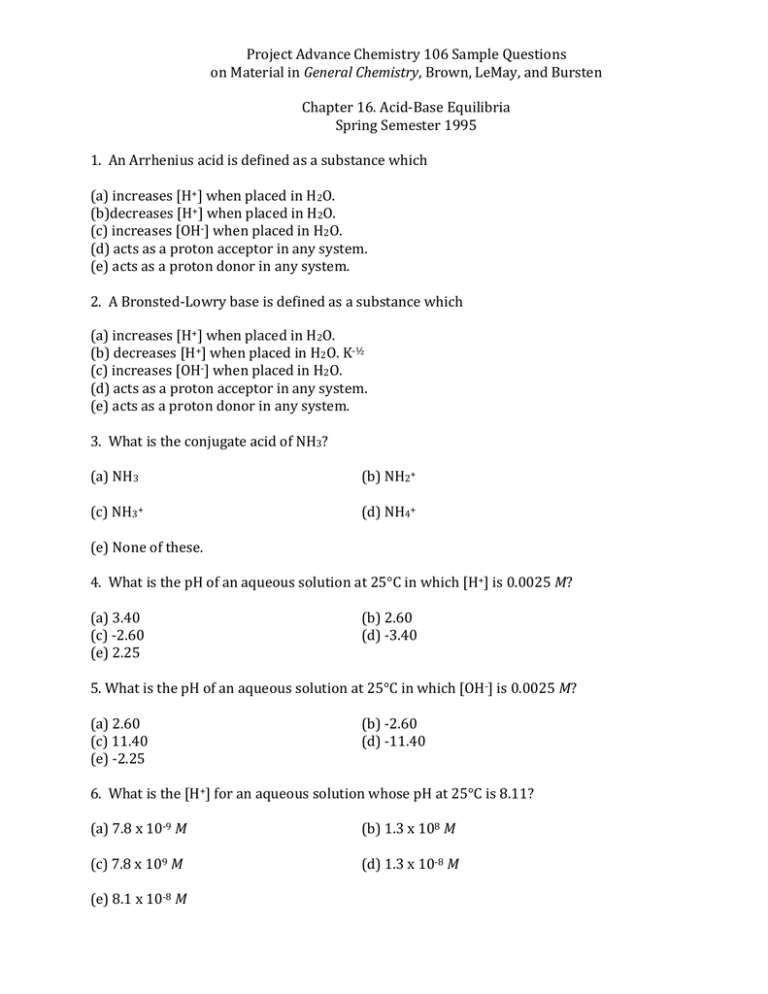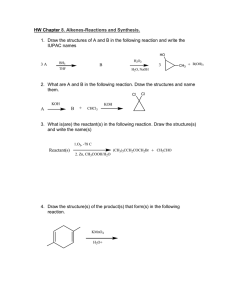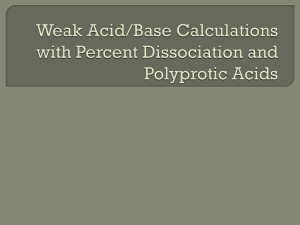95
advertisement

Project Advance Chemistry 106 Sample Questions on Material in General Chemistry, Brown, LeMay, and Bursten Chapter 16. Acid-Base Equilibria Spring Semester 1995 1. An Arrhenius acid is defined as a substance which (a) increases [H+] when placed in H2O. (b)decreases [H+] when placed in H2O. (c) increases [OH-] when placed in H2O. (d) acts as a proton acceptor in any system. (e) acts as a proton donor in any system. 2. A Bronsted-Lowry base is defined as a substance which (a) increases [H+] when placed in H2O. (b) decreases [H+] when placed in H2O. K-½ (c) increases [OH-] when placed in H2O. (d) acts as a proton acceptor in any system. (e) acts as a proton donor in any system. 3. What is the conjugate acid of NH3? (a) NH3 (b) NH2+ (c) NH3+ (d) NH4+ (e) None of these. 4. What is the pH of an aqueous solution at 25°C in which [H+] is 0.0025 M? (a) 3.40 (c) -2.60 (e) 2.25 (b) 2.60 (d) -3.40 5. What is the pH of an aqueous solution at 25°C in which [OH-] is 0.0025 M? (a) 2.60 (c) 11.40 (e) -2.25 (b) -2.60 (d) -11.40 6. What is the [H+] for an aqueous solution whose pH at 25°C is 8.11? (a) 7.8 x 10-9 M (b) 1.3 x 108 M (c) 7.8 x 109 M (d) 1.3 x 10-8 M (e) 8.1 x 10-8 M 7. The [H+] and pH of 0.021 M HNO3 at 25°C are (a) 4.8 x 10-13 M and 12.32, respectively. (b) 4.8 x 10-13 M and -12.32, respectively. (c) 0.021 M and 1.68, respectively. (d) 0.021 M and -1.68, respectively. (e) 4.8 x 10-6 M and 5.32, respectively. 8. Which of the following reactions is a Bronsted-Lowry acid-base reaction? (a) Ca2+ + 2OH- → Ca(OH)2 (b) (CH3)3C+ + H2O →(CH3)3COH2+ (c) (CH3)3COH + H3O+ → (CH3)3COH2+ + H2O (d) CO2 + H2O → H+ + HCO3(e) H2C = CH2 + H2 H3CCH3 9. Which of the following reactions is an example of autoionization? (a) 2(CH3)2C = CH2 (CH3)3CCH2C(CH3) = CH2 (b) HCl + H2O H3O+ + Cl(c) H3PO4 + PO43- H2PO4- + HPO42(d) 2HPO42- H2PO4- + PO43(e) 2NO2 N2O4 10. The conjugate acid of H2PO4- is (a) H3O+ (c) HPO42(e) H3PO4 (b) PO43(d) H2PO3- 11. If pH = 9.7 then [H+] = ______________. (a) 5 x 109 (c) 6 x 10-5 (e) 2 x 10-10 (b) 2 x 104 (d) 7 x 10-9 12. In 0.025 M CICH2COOH, [H+] = ________________. (a) -0.0067 (c) 0.0053 (e) 0.0025 (b) 3.5 x 10-5 (d) 0.0059 13. An aqueous solution of the weak acid HZ, initially 0.020 M HZ, has a pH of 4.93 at 25˚C. What is Ka for HZ at this temperature? (a) 1.2 x 10-5 (c) 1.4 x 10-10 (e) 2.8 x 10-12 (b) 6.9 x 10-9 (d) 9.9 x 10-2 14. Which one of the acids shown in the table below is the weakest? (a) HOAc (b) HN3 (c) HCOOH (d) HCIO (e) They are all strong acids. Acid HOAc HN3 HCOOH HCIO Ka at 25°C 1.8 x 10-5 1.9 x 10-5 1.8 x 10-4 3.0 x 10-8 15. What is the pH of a 0.15 M solution of acetic acid, HOAc? (a) 5.57 (b) 7.35 (c) 2.78 (d) 9.18 (e) none of these. Acid HOAc HN3 HCOOH HCIO Ka at 25°C 1.8 x 10-5 1.9 x 10-5 1.8 x 10-4 3.0 x 10-8 16. What is the percent ionization of hypochlorous acid (HClO) in a 0.015 M solution of HClO? (a) 4.5 x 10-8 (c) 2.1 x 10-5 (e) 100% (b) 14 (d) 0.14 17. What is the pH of a 0.011 sodium hydroxide solution at 25°C? (a) 1.96 (c) 12.4 (e) none of these. (b) 4.51 (d) 12.90 18. Which of the following possesses the greatest concentration of hydrozide ion at 25°C? (a) a solution with a pH of 3.0 (b) a 1 x 10-4 M solution of HNO3 (c) a solution with a pOH of 12.0 (d) water (e) a solution prepared by adding 1 x 10-9 mol of HCl to 1.00 L of water. 19. What is the pH of a 0.35 M solution of methylamine, CH3NH2, in water at 25°C? The Kb of methylamine is 4.4 x 10-4 . (a) 10.19 (c) 12.09 (e) none of these. (b) 3.81 (d) 1.91 20. The Ka for HOCl is 3.0 x 10-8. The Kb for hypochlorous ion, ClO- , is (a) 3.3 x 10-7 (b) 3.0 x 10-22 (c) 3.0 x 108 (d) 9.0 x 10-16 (e) 1.7 x 10-4 21. The Kb for NH3 is 1.8 x 10—5. What is the pH of a 0.35 M solution of ammonium chloride, NH4Cl? (a) 9.71 (c) 9.14 (e) none of these. (b) 4.29 (d) 4.86 22. In a 0.10 M aqueous solution of each salt shown below which salt solution will have the lowest pH? (a) KNO3 (b) Ca(NO3)2 (c) NH4NO3 (d) KCl (e) BaBr2 23. Which one of the following reactions will not go to completion? (a) HCl(g) + H2O(l) → H3O+(aq) + Cl- (aq) (b) HOAc(l) + H2O(l) H3O+(aq) + OAc(c) HOAc(aq) + NaOH(aq) NaOAc(aq) + H2O(l) (d) NH3(aq) + HCl(aq) NH4Cl(aq) (e) All the reactions go to completion. 24. Which one the following is true for any diprotic acid, H2X? (a) Ka1 > Ka2 (b) Ka2 = Ka1 (c) Ka1 < Ka2 (d) Ka1 ≥ Ka2 (e) Ka1 = 1/Ka2 25. In the following reaction: Cu2+(aq) + 4CN-(aq) Cu(CN)42-(aq) (a) Cu2+ is acting as a Lewis base. (b) Cu2+ is acting as a Bronstad base. (c) CN- is acting as a Lewis acid. (d) CN- is acting as a Bronstad acid. (e) None of the above is correct.







